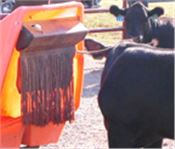Feed-Thru (Oral Larvicide) Insecticides For Pasture Fly Control
DR. LEE TOWNSEND
LEXINGTON, KY.
Eliminating or treating a pest’s breeding site is often right at the top of the list of pest management options. It can work if the breeding site is very specific – like freshly deposited cow manure, the egg-laying site of choice for female horn flies and face flies. This allows the option of feed-thru larvicides (insecticides that control fly larvae or maggots) that pass through the digestive tract and are present at toxic levels in manure.
Active ingredients used as oral larvicides include the insect growth regulator methoprene (Altosid) and the organophosphate insecticide tetrachlorvinophos (Rabon). Insect growth regulators affect the development of larvae and prevent them from emerging as adults. In contrast, organophosphate insecticides kill by disrupting normal function of the nervous system. In either case, these chemicals must be present in the manure at or above levels that are toxic to the larvae. Either active ingredient can be formulated in different ways and is available under several different brand names.
• Methoprene – Altosid 0.5 percent Premix Dose or Altosid 0.1 percent IGR Block – to prevent the breeding of horn flies in the manure of treated cattle.
• Tetrachlorvinophos – Rabon 7.76 Oral Larvicide Premix – to prevent development of horn flies and face flies in manure of treated beef and lactating dairy cattle.
• Diflubenzuron – ClariFly Larvicide – for horn flies and face flies feed additive
Dose rates are based on milligrams of insecticide active ingredient per 100 pounds of body weight per animal per day.
General Recommendations for Oral Larvicides
• Start feeding in early spring before flies begin to appear, and continue until cold weather restricts fly activity.
• Ensure adequate consumption by all animals.
• Monitor consumption to determine if adequate dose rate is eaten; adjust as necessary.
• Use supplemental adult fly control methods as necessary.
Points to Consider
• What is the cost per head? This will take some calculations to compare options based on minimum consumption rates, herd size, and alternatives.
• What is your key pasture fly pest? Both active ingredients are labeled for horn fly control; products containing tetrachlorvinophos are labeled also for face flies.
• How well do your neighbors control pasture flies and how close are their herds? Movement of horn and face flies from nearby cattle can keep numbers on your animals above acceptable levels, even if your larvicide program is working well. Is there room in the budget for some supplemental control (dust bag, etc.) if necessary?
• Can or will you check consumption of the oral larvicide to see if enough is being eaten? This could mean weighing some salt blocks, etc. and relocating mineral feeders if consumption is low.
• Keep some estimate of flies per head to see if numbers are growing drastically – an indication of either poor control or arrival of flies from an off-farm source. ∆
DR. LEE TOWNSEND: Extension Entomologist, University of Kentucky

Figure 1. Mineral feeders can be modified with a face wipe
to provide control of adult face flies and horn flies.
Photo: Lee Townsend, UK